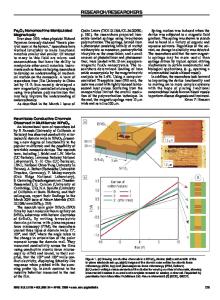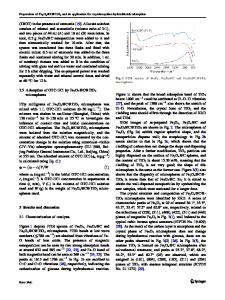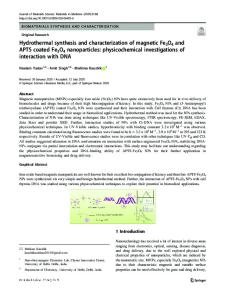Mesoporous Fe 3 O 4 @C nanoarrays as high-performance anode for rechargeable Ni/Fe battery
- PDF / 5,320,834 Bytes
- 9 Pages / 595.276 x 793.701 pts Page_size
- 76 Downloads / 365 Views
Published online 10 November 2020 | https://doi.org/10.1007/s40843-020-1510-4
Mesoporous Fe3O4@C nanoarrays as highperformance anode for rechargeable Ni/Fe battery †
†
*
*
Tianyu Zhang , Can Yang , Shilun Sun, Yanmei Huang, Ge Meng , Aijuan Han and Junfeng Liu ABSTRACT Rechargeable aqueous batteries with high power density and energy density are highly desired for electrochemical energy storage. Despite the recent reports of various cathode materials with ultrahigh pseudocapacitance exceeding −1 −1 3000 F g (or 800 mA h g ), the development of anode materials is relatively insufficient, which limits the whole performance of the devices far from practical applications. Herein, we report the preparation of mesoporous Fe3O4@C nanoarrays as high-performance anode for rechargeable Ni/Fe battery by a self-generated sacrificial template method. ZnO/ Fe3O4 composite was first synthesized by a co-deposition process, and ZnO was subsequently removed by alkali etching to construct the mesoporous structure. A thin carbon film was introduced onto the surface of the electrode by the carbonization of glucose to increase the structural stability of the electrode. The unique mesoporous nanoarray architecture endows the electrode with larger specific surface area, faster charge/mass transport and higher utilization of Fe3O4, which −1 shows an ultrahigh specific capacity (292.4 mA h g at a −2 current density of 5 mA cm ) and superior stability in aqueous electrolyte (capacitance retention of 90.8% after 5000 cycles). After assembled with hierarchical mesoporous NiO nanoarray as a cathode, an optimized rechargeable Ni/Fe battery with double mesoporous nanoarray electrodes was fabricated, which provided high energy/power densities −1 −1 −1 (213.3 W h kg at 0.658 kW kg and 20.7 kW kg at −1 113.9 W h kg , based on the total mass of the active materials) in the potential window of 1.5 V with excellent cyclability (81.7% retention after 5000 charge/discharge cycles). Keywords: Fe3O4, mesoporous, nanoarray, anode, Ni/Fe battery
INTRODUCTION Energy storage in rechargeable batteries is paramount to our daily life; however, they are still far from perfect [1– 3]. Lithium-ion batteries are widely regarded as the op-
*
timal power sources, but the risk of fire and explosion due to the use of flammable organic electrolytes greatly hinders their applications [4,5]. In contrast, aqueous rechargeable batteries featuring nonflammable water-based electrolytes are intrinsically safe, stable, and cost-effective [6,7]. Among various aqueous batteries, the alkaline Ni/ Fe battery has attracted much attention because Ni and Fe are earth-abundant, ecofriendly, and rather cheap compared with other alternatives [8]. Despite these merits, the relatively low power/energy density and short cycle life of Ni/Fe battery limit their wide applications [9,10]. To improve their performance, delicate design and synthesis of nanostructured electrodes have been widely reported [11–16]. For example, hierarchical mesoporous NiO nanoarray with three-dimensional porou
Data Loading...











